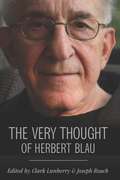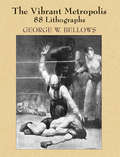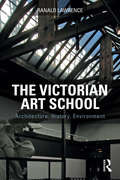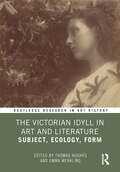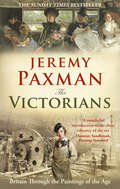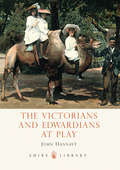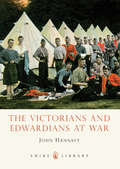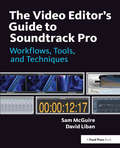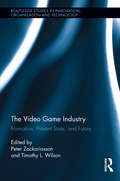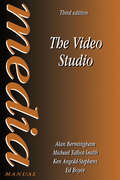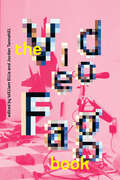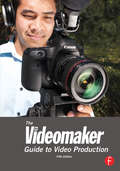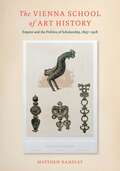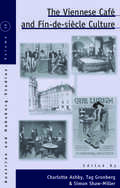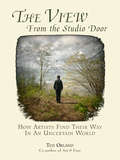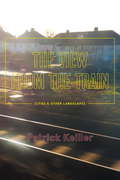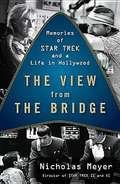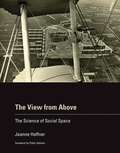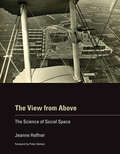- Table View
- List View
The Very Pointless Quiz Book: Prove your Pointless Credentials (Pointless Books #3)
by Alexander Armstrong Richard OsmanLet hosts Alexander Armstrong and Richard Osman guide you through the quiz rounds with their trademark warmth and humour and battle it out against your friends and family for Pointless glory. Perfect for playing along alone or with family and friends, The Very Pointless Quiz Book will test your knowledge and tease your brains.So how good are you at Pointless? Really? Do you think you've got enough in-depth knowledge of Regional Railways, African Countries With No Coastline and Types of Lettuce to carry off the coveted Pointless trophy?Well let's see shall we?Here's your chance to step up to the podium (metaphorically speaking of course, chances are you'll be sitting somewhere very comfortably with either a mug of tea or a roll of Andrex within easy reach) put that knowledge to the test, and see just how far you can go in a genuine four-round Pointless ordeal.Right, if everyone's ready, let's play Pointless...
The Very Thought of Herbert Blau
by Joseph Roach Clark LunberryHerbert Blau (1926–2013) was the most influential theater theorist, practitioner, and educator of his generation. He was the leading American interpreter of the works of Samuel Beckett and as a director was instrumental in introducing works of the European avant-garde to American audiences. He was also one of the most far-reaching and thoughtful American theorists of theater and performance, and author of influential books such as The Dubious Spectacle, The Audience, and Take Up the Bodies: Theater at the Vanishing Point. In The Very Thought of Herbert Blau, distinguished artists and scholars offer reflections on what made Blau's contributions so visionary, transformative, and unforgettable, and why his ideas endure in both seminar rooms and studios. The contributors, including Lee Breuer, Sue-Ellen Case, Gautam Dasgupta, Elin Diamond, S. E. Gontarski, Linda Gregerson, Martin Harries, Bill Irwin, Julia Jarcho, Anthony Kubiak, Daniel Listoe, Clark Lunberry, Bonnie Marranca, Peggy Phelan, Joseph Roach, Richard Schechner, Morton Subotnick, Julie Taymor, and Gregory Whitehead, respond to Blau's fierce and polymorphous intellect, his relentless drive and determination, and his audacity, his authority, to think, as he frequently insisted, "at the very nerve ends of thought."
The Vibrant Metropolis: 88 Lithographs
by Carol Belanger Grafton George W. BellowsThis handsome volume is an original selection of Bellow's best lithographs depicting a wide array of subjects, from portraits and nudes to street life and prize fighting. Brilliantly executed, richly evocative works include Nude in a Bed, Evening, In the Subway, Dempsey Through the Ropes, and Base Hospital.
The Victorian Art School: Architecture, History, Environment
by Ranald LawrenceThe Victorian Art School documents the history of the art school in the nineteenth century, from its origins in South Kensington to its proliferation through the major industrial centres of Britain. Charles Rennie Mackintosh’s Glasgow School of Art, together with earlier examples in Manchester and Birmingham demonstrate an unprecedented concern for the provision of plentiful light and air amidst the pollution of the Victorian city. As theories of design education and local governance converged, they also reveal the struggle of the provincial city for cultural independence from the capital. Examining innovations in the use of new technologies and approaches in the design of these buildings, The Victorian Art School offers a unique and explicitly environmental reading of the Victorian city. It examines how art schools complemented civic ‘Improvement’ programmes, their contribution to the evolution of art pedagogy, the tensions that arose between the provincial schools and the capital, and the role they would play in reimagining the relationship between art and public life in a rapidly transforming society. The architects of these buildings synthesised the potential of art with the perfection of the internal environment, indelibly shaping the future cultural life of Britain.
The Victorian Idyll in Art and Literature: Subject, Ecology, Form (Routledge Research in Art History)
by Thomas Hughes Emma MerklingResonating with contemporary ecological and queer theory, this book pioneers the theorization of the Victorian idyll, establishing its nature, lineaments, and significance as a formal mode widely practised in nineteenth-century British culture across media and genre. Chapters trace the Victorian idyll’s emergence in the 1830s, its flourishing in the 1860s, and its evolution up to the century’s close, drawing attention to the radicalism of idyllic experiments with pictorial, photographic, dramatic, literary, and poetic form in the work of canonical and lesser-known figures. Approaching the idyll through three intersecting categories—subject, ecology, and form—this book remaps Victorian culture, reshaping thinking about artistic form in the nineteenth century, and recalibrating accepted chronologies. In the representations by a host of Victorian artists and writers engaging with other-than-human forms, and in the natures of the subjectivities animated by these encounters, we find versions of Victorian ecology providing provocative imaginative material for ecocritics, scholars, writers, and artists today. This book will be of interest to scholars working in art history, English literature, Victorian studies, British history, queer and trans* theory, musicology, and ecocriticism, and will enliven debates pertaining to the environmental across periods.
The Victorian Novel and the Space of Art
by Dehn GilmoreThis interdisciplinary study argues for the vital importance of visual culture as a force shaping the Victorian novel's formal development and reading history. It shows how authors like Charles Dickens, William Makepeace Thackeray, Wilkie Collins and Thomas Hardy borrowed language and conceptual formations from art world spaces - the art market, the museum, the large-scale exhibition, and art critical discourse - not only when they chose certain subjects or refined certain aspects of realism, but also when they tried to adapt various genres of the novel for a new and newly vociferous mass audience. Quandaries specific to new forms of public display affected authors' sense of their relationship with their own public. Debates about how best to appreciate a new mass of visual information impacted authors' sense of how people read, and consequently the development of particular novel forms like the multi-plot novel, the historical novel, the sensation novel, and fin-de-sicle fiction.
The Victorian Painting of Modern Life (British Art: Histories and Interpretations since 1700)
by Pamela FletcherThis text offers a comprehensive and tightly focused account of the emergence and flourishing of British modern-life paintings at midcentury. Contemporary subjects were new and risky in the late 1840s and early 1850s; immensely popular and much debated by 1858; and already falling out of fashion by the mid-1860s. The book follows this story chronologically, moving from the anxious attempts by young artists such as William Powell Frith and William Holman Hunt to capture modern life in a visual language that conveyed both the literal and emotional truths of contemporary experience, through the new genre’s explosion into popularity in the later 1850s and early 1860s, and the critical debates (and changing fashions) that led to its diminishment by the end of that decade. The book will be of interest to scholars working in art history, British studies, visual culture, exhibition culture, museum studies, and the sociology of art.
The Victorians
by Jeremy PaxmanJeremy Paxman's unique portrait of the Victorian age takes readers on an exciting journey through the birth of modern Britain. Using the paintings of the era as a starting point, he tells us stories of urban life, family, faith, industry and empire that helped define the Victorian spirit and imagination.To Paxman, these paintings were the television of their day, and his exploration of Victorian art and society shows how these artists were chronicling a world changing before their eyes. This enthralling history is Paxman at his best - opinionated, informed, witty, surprising - and a glorious reminder of how the Victorians made us who we are today.
The Victorians and Edwardians at Play
by John HannavyA picture can say a thousand words and the images caught on camera during the Victorian and Edwardian periods provide a fascinating insight into the lives of Britons during this time. Take a step back between 1840 and 1910 and explore the pastimes, hobbies, sports and other entertainments enjoyed by the Victorians and Edwardians through the rich variety of photographs and vintage postcards in this beautiful album. A world we usually see in monochrome or sepia is presented here in vivid color, bringing the Victorian and Edwardian people a little closer to us. 128 pages are packed with images of people on the golf course, playing croquet and tennis, sports days and football matches. We see visits to the zoo, cruises on river boats and paddle steamers, fairground and pleasure beach excursions, days at the races and other, more unusual pursuits, all of which tell the story of social life 100 to 160 years ago. Go on, take a look!From the Trade Paperback edition.
The Victorians and Edwardians at War
by John HannavyBy the time the first photographs were taken at war in the late 1840s, the idea that 'the camera cannot lie' was already firmly embedded in the Victorian psyche. 'Truthful' in a way the work of the war artist could never be, despite the initially long exposures and cumbersome equipment, cameras have been used to document war ever since the celebrated photographs of Roger Fenton in the Crimea. Through a rich selection of images - many of them never before published - this book tells the story of the photographers who chronicled Britain's Victorian and Edwardian wars and those who fought in them.
The Video Editor's Guide to Soundtrack Pro: Workflows, Tools, and Techniques
by Paul Lee Sam McGuireThis book tells you how, why, and when you should perform certain audio postproduction tasks within Soundtrack Pro 3 while editing your video in the Final Cut Studio suite. Intertwining video editing workflows with audio editing workflows for video editors using Final Cut Studio 3, it also describes in-depth the audio postproduction process as well as the specific tools used for editing and mixing audio within Soundtrack Pro 3. The final section is designed as an audio postproduction "cook-book", describing typical audio post scenarios with detailed workflows for dealing with them.The book provides real-world workflows and step-by-step instruction on the basics of audio editing in STP3, implementing sound effects, spectral tools and much more. Also included is a DVD containing both video and audio files, demonstrating surround sound, mixing procedures, and other audio editing processes. Included as well are project files with which you can refine techniques learned in the book. The DVD is not included with the E-book. Please contact the publisher for access to the DVD content by emailing d.mcgonagle@elsevier.com.
The Video Game Industry: Formation, Present State, and Future (Routledge Studies in Innovation, Organizations and Technology)
by Edited by Peter Zackariasson Timothy L. WilsonThe Video Game Industry provides a platform for the research on the video game industry to draw a coherent and informative picture of this industry. Previously this has been done sparsely through conference papers, research articles, and popular science books. Although the study of this industry is still stigmatized as frivolous and ‘only’ game oriented, those who grew up with video games are changing things, especially research agendas, the acceptance of studies, and their interpretation. This book describes and defines video games as their own special medium. They are not pinball from which they grew, nor movies which they sometimes resemble. They are a unique form of entertainment based on meaningful interactions between individuals and machine across a growing sector of the population. The Video Game Industry provides a reference foundation for individuals seriously interested in the industry at the academic level. As a result, this book will serve as a reference in curricula associated with video game development for years to come.
The Video Studio
by Alan Bermingham Michael Talbot-Smith Ed Boyce Ken Angold-StephensThe recent demise of the independent television companies and the expansion of satellite and cable networks has led to an explosion in small, independent production facilities. In parallel with this development has been a steady increase in media training and a major expansion in corporate video facilities. The Video Studio is written for everyone contemplating setting-up a professional installation, whether studio or location based. The Video Studio shows how to estimate the scale of investment required and, depending on the nature and frequency of use of the facility, the layout of technical areas and the function of the main items of equipment is described in easy to understand language. In short this is a nuts and bolts approach to planning and operating a studio of 150 square metres or less. Completely updated to take account of all the recent technological advances which have taken place, the book now covers: DAT, timecode, digital compression, non-linear editing and all current digital video formats.
The Videofag Book
by William Ellis Jordan TannahillLonglisted for the 2018 Toronto Book AwardsIn October 2012, lovers William Ellis and Jordan Tannahill moved into a former barbershop in Toronto's Kensington Market neighbourhood and turned it into an art space called Videofag. Over the next four years Videofag became a hub for counterculture in the city, playing host to a litany of performances, screenings, parties, exhibitions, and all manner of queer fuckery. But hosting a city in their house took its toll and eventually William and Jordan broke up, closing the space for good in June 2016.The Videofag Book is a chronicle of those four years told through multiple voices and mediums: a personal history by William and Jordan; a love letter by Jon Davies; a communal oral history compiled by Chandler Levack; a play by Greg MacArthur; a poem by Aisha Sasha John; a chronological history of Videofag's programming; and a photo archive curated by William and Jordan in full colour.
The Videomaker Guide to Video Production
by VideomakerFrom the editors of Videomaker Magazine comes this new edition that you have been waiting for. The Videomaker Guide Digital Video, fourth edition, provides information on all of the latest cutting edge tools and techniques necessary to help you shoot and edit video like the pro's. Learn about equipment, lighting, editing, audio, high definition, and all aspects of video from the leading experts on videography!
The Vienna School of Art History: Empire and the Politics of Scholarship, 1847–1918
by Matthew RampleyMatthew Rampley’s The Vienna School of Art History is the first book in over seventy-five years to study in depth and in context the practices of art history from 1847, the year the first teaching position in the discipline was created, to 1918, the collapse of Austria-Hungary. It traces the emergence of art history as a discipline, the establishment of norms of scholarly inquiry, and the involvement of art historians in wider debates about the cultural and political identity of the monarchy. The so-called Vienna School plays the central role in the study, but Rampley also examines the formation of art history elsewhere in Austria-Hungary. Located in the Habsburg imperial capital, Vienna art historians frequently became entangled in debates that were of importance to art historians elsewhere in the Empire, and Rampley pays particular attention to these areas of overlapping interest. He also analyzes the methodological innovations for which the Vienna School was well known. Rampley focuses most fully, however, on the larger political and ideological context of the practice of art history—particularly the way in which art-historical debates served as proxies for wider arguments over the political, social, and cultural life of the Habsburg Empire.
The Vienna School of Art History: Empire and the Politics of Scholarship, 1847–1918
by Matthew RampleyMatthew Rampley’s The Vienna School of Art History is the first book in over seventy-five years to study in depth and in context the practices of art history from 1847, the year the first teaching position in the discipline was created, to 1918, the collapse of Austria-Hungary. It traces the emergence of art history as a discipline, the establishment of norms of scholarly inquiry, and the involvement of art historians in wider debates about the cultural and political identity of the monarchy. The so-called Vienna School plays the central role in the study, but Rampley also examines the formation of art history elsewhere in Austria-Hungary. Located in the Habsburg imperial capital, Vienna art historians frequently became entangled in debates that were of importance to art historians elsewhere in the Empire, and Rampley pays particular attention to these areas of overlapping interest. He also analyzes the methodological innovations for which the Vienna School was well known. Rampley focuses most fully, however, on the larger political and ideological context of the practice of art history—particularly the way in which art-historical debates served as proxies for wider arguments over the political, social, and cultural life of the Habsburg Empire.
The Viennese Cafe and Fin-de-Siecle Culture
by Simon Shaw-Miller Charlotte Ashby Tag GronbergThe Viennese cafe was a key site of urban modernity around 1900. In the rapidly growing city it functioned simultaneously as home and workplace, affording opportunities for both leisure and intellectual exchange. This volume explores the nature and function of the coffeehouse in the social, cultural, and political world of fin-de-siecle Vienna. Just as the cafe served as a creative meeting place within the city, so this volume initiates conversations between different disciplines focusing on Vienna at the beginning of the twentieth century. Contributions are drawn from the fields of social and cultural history, literary studies, Jewish studies and art, and architectural and design history. A fresh perspective is also provided by a selection of comparative articles exploring coffeehouse culture elsewhere in Eastern Europe.
The View From The Studio Door
by Ted OrlandIn the perennial best-seller Art & Fear, Ted Orland (with David Bayles) examined the obstacles that artists encounter each time they enter their studio and stand before a new blank canvas. Now, in The View From The Studio Door, Orland turns his attention to broader issues that stand to either side of that artistic moment of truth.In a text marked by grace, brevity and humor, Orland argues that when it comes to art making, theory and practice are always intertwined. There are timeless philosophical questions (How do we make sense of the world?) that address the very nature of art making, as well as gritty real-world questions (Is there art after graduation?) that artists encounter the moment they're off the starting blocks and producing work on a regular basis.Simply put, this is a book of practical philosophy. As a teacher and working artist himself, Orland brings authentic insight and encouragement to all those who face the challenge of making art in an uncertain world. The breadth of material covered is reflected in chapters that include Making Sense of the World, Art & Society, The Education of the Artist, Surviving Graduation, Making Art That Matters, The Artistic Community, and more.The View From The Studio Door is the perfect companion piece to Art & Fear, and will appeal to a similar (and already-established) audience of students, working artists, teachers and professionals. For students' benefit, The View is also modestly priced, with wide page margins for easy note-taking and annotation.
The View From The Train
by Patrick Keiller"Robinson believed that, if he looked at it hard enough, he could cause the surface of the city to reveal to him the molecular basis of historical events, and in this way he hoped to see into the future." In his sequence of films, Patrick Keiller retraces the hidden story of the places where we live, the cities and landscapes of our everyday lives. Now, in this brilliant collection of essays, he offers a new perspective on how Britain works and sees itself. He discusses the background to his work and its development - from surrealism to post-2008 economic catastrophe - and expands on what the films reveal. Referencing writers including Benjamin and Lefebvre, the essays follow his career since the late 1970s, exploring themes including the surrealist perception of the city; the relationship of architecture and film; how cities change over time, and how films represent this; as well as accounts of cross-country journeys involving historical figures, unexpected ideas and an urgent portrait of post-crash Britain.From the Hardcover edition.
The View From the Bridge: Memories of Star Trek and a Life in Hollywood
by Nicholas MeyerThe critically acclaimed director and writer shares his account of the making of the three classic Star Trek filmsThe View from the Bridge is Nicholas Meyer's enormously entertaining account of his involvement with the Star Trek films: STII: The Wrath of Khan, STIV: The Voyage Home, and STVI: The Undiscovered Country, as well as his illustrious career in the movie business. The man best known for bringing together Sherlock Holmes and Sigmund Freud in The Seven Per-Cent Solution had ironically never been interested in Star Trek until he was brought on board to save the film series. Meyer shares how he created the script for The Wrath of Khan, the most revered Star Trek film of all, in twelve days-only to have William Shatner proclaim he hated it. He reveals the death threats he received when word got out that Spock would be killed, and finally answers the long-pondered question of whether Khan's chiseled chest is truly that of Ricardo Montalban. Meyer's reminiscences on everyone from Gene Roddenberry to Laurence Olivier will appeal not only to the countless legions of Trekkies, but to anyone fascinated by the inner workings of Hollywood.
The View from Above
by Jeanne Haffner Peter GalisonIn mid-twentieth century France, the term "social space" ( l'espace social) -- the idea that spatial form and social life are inextricably linked -- emerged in a variety of social science disciplines. Taken up by the French New Left, it also came to inform the practice of urban planning. In The View from Above, Jeanne Haffner traces the evolution of the science of social space from the interwar period to the 1970s, illuminating in particular the role of aerial photography in this new way of conceptualizing socio-spatial relations. As early as the 1930s, the view from above served for Marcel Griaule and other anthropologists as a means of connecting the social and the spatial. Just a few decades later, the Marxist urban sociologist Henri Lefebvre called the perspective enabled by aerial photography -- a technique closely associated with the French colonial state and military -- "the space of state control." Lefebvre and others nevertheless used the notion of social space to recast the problem of massive modernist housing projects (grands ensembles) to encompass the modern suburb (banlieue) itself -- a critique that has contemporary resonance in light of the banlieue riots of 2005 and 2007. Haffner shows how such "views" permitted new ways of conceptualizing the old problem of housing to emerge. She also points to broader issues, including the influence of the colonies on the metropole, the application of sociological expertise to the study of the built environment, and the development of a spatially oriented critique of capitalism.
The View from Above: The Science of Social Space
by Jeanne HaffnerThe role of aerial photography in the evolution of the concept of social space”and its impact on French urban planning in the mid-twentieth century.In mid-twentieth century France, the term “social space” (l'espace social)—the idea that spatial form and social life are inextricably linked—emerged in a variety of social science disciplines. Taken up by the French New Left, it also came to inform the practice of urban planning. In The View from Above, Jeanne Haffner traces the evolution of the science of social space from the interwar period to the 1970s, illuminating in particular the role of aerial photography in this new way of conceptualizing socio-spatial relations. As early as the 1930s, the view from above served for Marcel Griaule and other anthropologists as a means of connecting the social and the spatial. Just a few decades later, the Marxist urban sociologist Henri Lefebvre called the perspective enabled by aerial photography—a technique closely associated with the French colonial state and military—“the space of state control.” Lefebvre and others nevertheless used the notion of social space to recast the problem of massive modernist housing projects (grands ensembles) to encompass the modern suburb (banlieue) itself—a critique that has contemporary resonance in light of the banlieue riots of 2005 and 2007. Haffner shows how such “views” permitted new ways of conceptualizing the old problem of housing to emerge. She also points to broader issues, including the influence of the colonies on the metropole, the application of sociological expertise to the study of the built environment, and the development of a spatially oriented critique of capitalism.
The View from Babylon: The Notes of a Hollywood Voyeur
by Donald RawleyRawley paints the definitive portrait of Hollywood in the '90s. A lifelong L.A. inhabitant, Rawley takes you on a tour beyond the city's edge - from Malibu's shining white beaches to lonely desert communities to big-studio arenas where life speeds by in "Hollywood time." He introduces a memorable cast of characters - a wistful, recovering methamphetamine addict; a loving father and dedicated ex-soldier driven by heartbreaking failure; the always glamorous, never satisfied Hollywood denizens at one of the industry's "big-big-big" premieres. The View from Babylon is a portrait of the city that reflects our deepest dreams and darkest desires.
The View from Highway 1: Essays on Television
by Michael J. ArlenA series of excellent essays that critique television and society. A highly recommended follow-up read to Arlen's "Living Room War".

